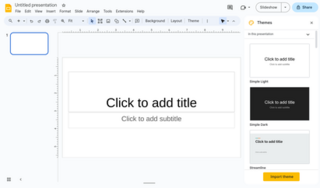Related Research Articles
Collaborative writing is a procedure in which two or more persons work together on a text of some kind. Success in collaborative writing involves a division of labor that apportions particular tasks to those with particular strengths: drafting, providing feedback, editing, sourcing, (reorganizing), optimizing for tone or house style, etc. Collaborative writing is characteristic of professional as well as educational settings, utilizing the expertise of those involved in the collaboration process.

In industry, product lifecycle management (PLM) is the process of managing the entire lifecycle of a product from its inception through the engineering, design and manufacture, as well as the service and disposal of manufactured products. PLM integrates people, data, processes, and business systems and provides a product information backbone for companies and their extended enterprises.
A translation management system (TMS), formerly globalization management system (GMS), is a type of software for automating many parts of the human language translation process and maximizing translator efficiency. The idea of a translation management system is to automate all repeatable and non-essential work that can be done by software/systems and leaving only the creative work of translation and review to be done by human beings. A translation management system generally includes at least two types of technology: process management technology to automate the flow of work, and linguistic technology to aid the translator.

Task management is the process of overseeing a task through its lifecycle. It involves planning, testing, tracking, and reporting. Task management can help individuals achieve goals or enable groups of individuals to collaborate and share knowledge for the accomplishment of collective goals. Tasks are also differentiated by complexity, from low to high.

Crowdsourcing involves a large group of dispersed participants contributing or producing goods or services—including ideas, votes, micro-tasks, and finances—for payment or as volunteers. Contemporary crowdsourcing often involves digital platforms to attract and divide work between participants to achieve a cumulative result. Crowdsourcing is not limited to online activity, however, and there are various historical examples of crowdsourcing. The word crowdsourcing is a portmanteau of "crowd" and "outsourcing". In contrast to outsourcing, crowdsourcing usually involves less specific and more public groups of participants.
An integrated collaboration environment (ICE) is an environment in which a virtual team does its work. Such environments allow companies to realize a number of competitive advantages by using their existing computers and network infrastructure for group and personal collaboration. These fully featured environments combine the best features of web-based conferencing and collaboration, desktop videoconferencing, and instant message into a single easy-to-use, intuitive environment. Recent developments have allowed companies include streaming in real-time and archived modes into their ICE.
Azure DevOps Server, formerly known as Team Foundation Server (TFS) and Visual Studio Team System (VSTS), is a Microsoft product that provides version control, reporting, requirements management, project management, automated builds, testing and release management capabilities. It covers the entire application lifecycle and enables DevOps capabilities. Azure DevOps can be used as a back-end to numerous integrated development environments (IDEs) but is tailored for Microsoft Visual Studio and Eclipse on all platforms.
A workflow management system provides an infrastructure for the set-up, performance, and monitoring of a defined sequence of tasks arranged as a workflow application.
In software engineering, team programming is a project management strategy for coordinating task distribution in computer software development projects, which involves the assignment of two or more computer programmers to work collaboratively on an individual sub-task within a larger programming project. In general, the manner in which this term is used today refers to methods currently in vogue within the software development industry where multiple individuals work simultaneously on the same activity; in these systems, programmers are often grouped in pairs at the same computer workstation, one observing the other working on the software and alternating roles at time intervals.
Business process management (BPM) is the discipline in which people use various methods to discover, model, analyze, measure, improve, optimize, and automate business processes. Any combination of methods used to manage a company's business processes is BPM. Processes can be structured and repeatable or unstructured and variable. Though not required, enabling technologies are often used with BPM.
Cloud collaboration is a method of sharing and co-authoring computer files via cloud computing, whereby documents are uploaded to a central "cloud" for storage, where they can then be accessed by other users. Cloud collaboration technologies allow users to upload, comment and collaborate on documents and even amend the document itself, evolving the document. Businesses in the last few years have increasingly been switching to use of cloud collaboration.
The use of crowdsourcing and text corpus in human-machine translation (HMT) within the last few years have become predominant in their area, in comparison to solely using machine translation (MT). There have been a few recent academic journals looking into the benefits that using crowdsourcing as a translation technique could bring to the current approach to the task and how it could help improve and make more efficient the current tools available to the public.
Collaborative workflow is the convergence of social software with service management (workflow) software. As the definition implies, collaborative workflow is derived from both workflow software and social software such as chat, instant messaging, and document collaboration.
Crowdsourcing software development or software crowdsourcing is an emerging area of software engineering. It is an open call for participation in any task of software development, including documentation, design, coding and testing. These tasks are normally conducted by either members of a software enterprise or people contracted by the enterprise. But in software crowdsourcing, all the tasks can be assigned to or are addressed by members of the general public. Individuals and teams may also participate in crowdsourcing contests.

Google Slides is a presentation program and part of the free, web-based Google Docs suite offered by Google. Google Slides is available as a web application, mobile app for: Android, iOS, and as a desktop application on Google's ChromeOS. The app is compatible with Microsoft PowerPoint file formats. The app allows users to create and edit files online while collaborating with other users in real-time. Edits are tracked by a user with a revision history presenting changes. An editor's position is highlighted with an editor-specific color and cursor and a permissions system regulates what users can do. Updates have introduced features using machine learning, including "Explore," offering and "tasks to other users."
Distributed Collaboration is a way of collaboration wherein participants, regardless of their location, work together to reach a certain goal. This usually entails use of increasingly popular cyberinfrastructure, such as emails, instant messaging and document sharing platforms to reduce the limitations of the users trying to work together from remote locations by overcoming physical barriers of geolocation and also to some extent, depending on the application used, the effects of working together in person. For example, a caller software that can be used to bring all collaborators into a single call-in for easier dissemination of ideas.
Crowdin is a proprietary, cloud-based localization technology and services company. It provides software as a service for commercial products, and it provides software free of charge for non-commercial open source projects, and educational projects.

Google Chat is a communication service developed by Google. Initially designed for teams and business environments, it has since been made available for general consumers. It provides direct messaging, group conversations, and spaces, which allow users to create and assign tasks and share files in a central place in addition to chatting. It can be accessed through its own website and app or through the Gmail website and app.

Tables is a collaborative database program developed out of Google's Area 120 incubator. Tables is available as a web application. The app allows users to collaborate in real-time to track work more efficiently using automation.
References
- ↑ Laurenti F., Villareale F., (2024). "Traduzione, ambienti virtuali e nuove tecnologie: strumenti informatici per la collaborazione". Testo a fronte. Marcos y Marcos.
- ↑ khulnaview (2011-05-20). "Wanted: Best practices in collaborative translation | Best practices | TAUS - Enabling better translation". Translationautomation.com. Archived from the original on 2012-11-03. Retrieved 2012-06-12.
- ↑ "Cloud Translation | Collaborative Translation". Wordbee. 2013-01-18. Archived from the original on 2013-02-09. Retrieved 2013-10-26.
- ↑ "Towards an integrated crowdsourcing definition" (PDF). Crowdsourcing-blog.org. Retrieved 2013-10-26.
- ↑ Hosaka, Tomoko A. (2008-04-18). "Facebook asks users to translate for free - Technology & science - Internet - NBC News". NBC News. Retrieved 2012-06-12.
- ↑ "Structuring Collaborative Translation 2.0 - Less Delivery Time, Better Quality". Scribd.com. Retrieved 2012-06-12.
- ↑ "XTM International official website".
- ↑ Laurenti F., Velardi S. (2022). “Collaborative translation: a bibliography”. La traduzione collaborativa. ISBN 979-12-218-0422-5. DOI 10.53136/979122180422516.